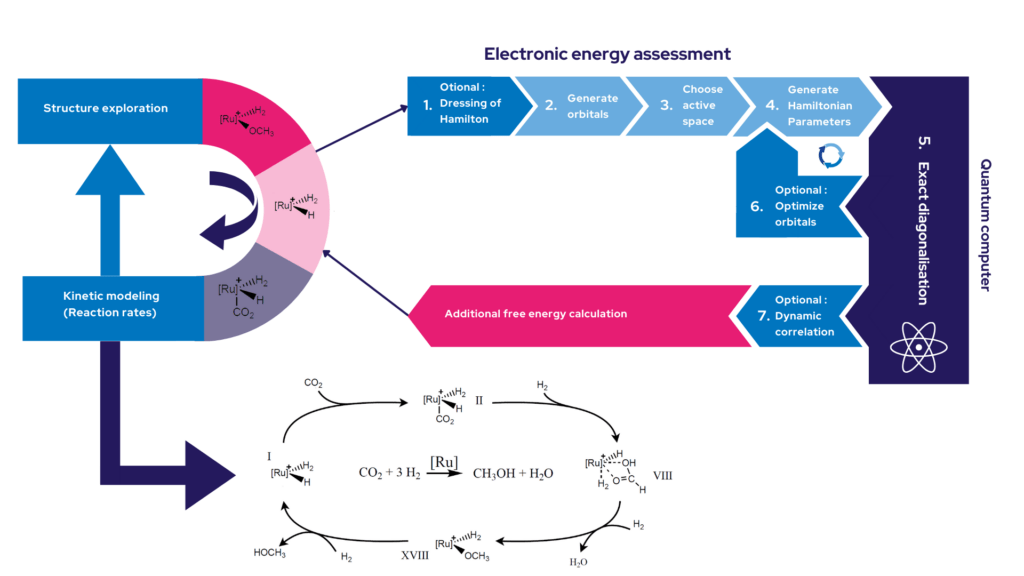What do quantum algorithms have to do with the circular carbon economy? Carbon capture is emerging as a GHG emissions mitigation strategy. Storing the carbon captured is not enough, however. To move toward a circular carbon economy, the carbon must be recycled into molecules of interest for things like fuels and construction materials by means of complex chemical reactions that will require new catalysts. Quantum computing could help engineer new chemical catalysts within the timeframes required to effectively offset GHG emissions on the road to a Net Zero economy.
From CCS to CCU for a circular carbon economy
Carbon capture and sequestration (CCS) is emerging as a solution to mitigate greenhouse gas emissions. There are currently dozens of projects underway around the globe to capture carbon at industrial point sources and store it, effectively producing “negative emissions” until less polluting industrial processes can be implemented—something that is currently not happening nearly quickly enough to keep the world on course toward Net Zero targets.
In CCS scenarios, the carbon captured is buried deep underground or under the sea, a costly process that is not without its risks. A complete carbon value chain will require going further by transforming the carbon captured into molecules of interest, effectively recycling it: This is called carbon capture and utilization (CCU), and it requires exactly the kind of complex chemical calculations that quantum computing is inherently good at.
Quantum ideal for complex chemical engineering problems like catalyst design
It all comes down to catalysts. To convert captured carbon into methanol and other useful chemicals requires efficient chemical processes that do not consume so much energy so as to negate their benefits. Catalyst development—which can take years using conventional computers—involves simulating chemical reactions to determine which potential candidates will result in the most efficient process.

Because molecules obey the same laws of quantum mechanics as qubits, quantum computers are inherently ideally suited to this type of chemical engineering problem.
AI can shorten the list of catalysts, but it can’t simulate their behavior
Artificial intelligence algorithms implemented on classical computers have been used to attempt to address intractable problems for which there is currently no useful classically-computed solution at scale. Simulating chemical reactions is one of these problems. The issue with AI is that, unlike quantum algorithms, high-quality and abundant training data is needed, and training AI models is expensive and time consuming.
For the development of new catalysts, AI can effectively be leveraged to narrow the potential dataset—one of the early stages of new catalyst development. Once this has been done, quantum algorithms have the capacity to speed up the simulation of chemical reactions by calculating molecular properties and electronic structures. Quantum can also be used to optimize the chosen catalysts by enabling additional simulation to fine-tune their properties. The exploration of different atomic configurations required at this stage are out of reach of classical computing solutions.
Computational catalysis creates exponential complexity
Quantum computers with millions of qubits can run algorithms already theoretically proven for computational chemistry. The Quantum Phase Estimation (QPE) algorithm is one such algorithm. According to Boston Consulting Group, “When it comes to emission reduction, some of the earliest applications for quantum computing could be among the most important.” And the potential market could be worth tens of billions per year.

For the carbon economy, quantum will speed up computational catalysis, an approach that uses computer models to predict the behavior of potential catalysts by determining the electronic energy states involved in a given chemical reaction. For large molecular systems, the complexity of this kind of calculation increases exponentially. This is where classical computers fall short.
The algorithms involved computational catalysis can effectively be run on the kind of quantum computer being developed by Quobly. Quobly’s quantum processing unit (QPU) could revolutionize electronic structure computation by accurately calculating the exact diagonalization energy of a molecular system of around 100 atoms in the full single-particle basis set, for example.
Quobly is accelerating the development of a silicon quantum computer with quantum advantage for chemistry
When it comes to the climate, we need to move fast. Regardless of which climate scenario you look at, the next ten years will be decisive in removing CO2 from the atmosphere. Quobly’s technology—the silicon spin qubit—is still young, but it offers strong potential for rapid development and deployment. Quobly will go beyond Moore by enabling a computational cost reduction over classical compute, effectively bringing quantum advantage to the computational catalysis market before any known competitor. In short, our scaleup plan will leverage classical commercial silicon process technologies available in existing fabs to bring a quantum processing unit to the market within a timeframe short enough to impact the climate.
Learn more about the science behind quantum chemistry
- Quantum computing enhanced computational catalysis
- Elucidating reaction mechanisms on quantum computers
- Simulated Quantum Computation of Molecular Energies
- Rapid initial state preparation for the quantum simulation of strongly correlated molecules
- Quantum Algorithms for Quantum Chemistry and Quantum Materials Science
